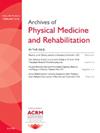NIDILRR ARRT: A Culturally Informed Lens on Assistive Technology Provision
IF 3.6
2区 医学
Q1 REHABILITATION
Archives of physical medicine and rehabilitation
Pub Date : 2025-04-01
DOI:10.1016/j.apmr.2025.01.004
引用次数: 0
Abstract
Objectives
To investigate the experience of assistive technology (AT) for people with disability from cultural backgrounds, particularly those rooted in a collectivist framework prevalent in many Asian, South American, African, and Middle Eastern countries. The project seeks to explore the tensions that may arise for multicultural AT users when navigating a Western-centric AT provision ecosystem. The goal of the study is to explore alternative understandings of assistance, providing a more inclusive examination of AT use and disuse from a multicultural perspective.
Design
This is an observational and interview study for understanding current practices in matching people with disabilities with the right AT. During observations of and interviews with people who use AT and people who provide them, we focus on identifying barriers and challenges associated with the use of ATs.
Setting
This study was carried out at Open Doors for Multicultural Families, a Seattle-based nonprofit organization that provides services to help people with disability find the right ATs.
Participants
We interviewed people with disabilities who receive support services to find AT. We used convenience sampling and included participants who regularly use AT for disability or accessibility reasons. The types of AT being used range from those that address vision, hearing, mobility, and developmental disabilities. We also interviewed case managers who provide AT support services at Open Doors.
Interventions
Not applicable.
Main Outcome Measures
We asked people with disabilities and caregivers about the challenges they encounter in getting the AT they need. We asked case managers and AT professionals about how they handle language or cultural barriers in supporting families in getting AT and how they adapt AT solutions to meet individual needs.
Results
The participants seeking AT reported that they are often unaware of the services available to them and the kinds of AT that could benefit them. AT professionals reported that case managers often construe individual needs in a way that leads to delayed consideration or oversight of AT despite their potential to effectively address the needs of individuals with disabilities. This study demonstrates that the decision to adopt AT as a solution to an access problem is far from a straightforward process. It involves a complex interplay of structural forces and power relations among various interest groups informed by differing values and priorities. We argue that by attending to the AT provision pipeline as a site for critical examination, we can bring valuable knowledge to AT practitioners and designers in exploring alternative approaches using cultural lens.
Conclusions
In this study, we adopt a cultural lens on AT provision. We examine the ways that culture can influence how AT is understood. This study demonstrates that the decision to adopt AT as a solution to an access problem is far from a straightforward process. It involves a complex interplay of structural forces and power relations among various interest groups informed by differing values, and priorities. We argue that by attending the AT provision pipeline as a site for critical examination, we can bring valuable knowledge to AT practitioners and designers in exploring alternative approaches to accounting for culture.
Disclosures
none.
求助全文
约1分钟内获得全文
求助全文
来源期刊
CiteScore
6.20
自引率
4.70%
发文量
495
审稿时长
38 days
期刊介绍:
The Archives of Physical Medicine and Rehabilitation publishes original, peer-reviewed research and clinical reports on important trends and developments in physical medicine and rehabilitation and related fields. This international journal brings researchers and clinicians authoritative information on the therapeutic utilization of physical, behavioral and pharmaceutical agents in providing comprehensive care for individuals with chronic illness and disabilities.
Archives began publication in 1920, publishes monthly, and is the official journal of the American Congress of Rehabilitation Medicine. Its papers are cited more often than any other rehabilitation journal.

 求助内容:
求助内容: 应助结果提醒方式:
应助结果提醒方式:


